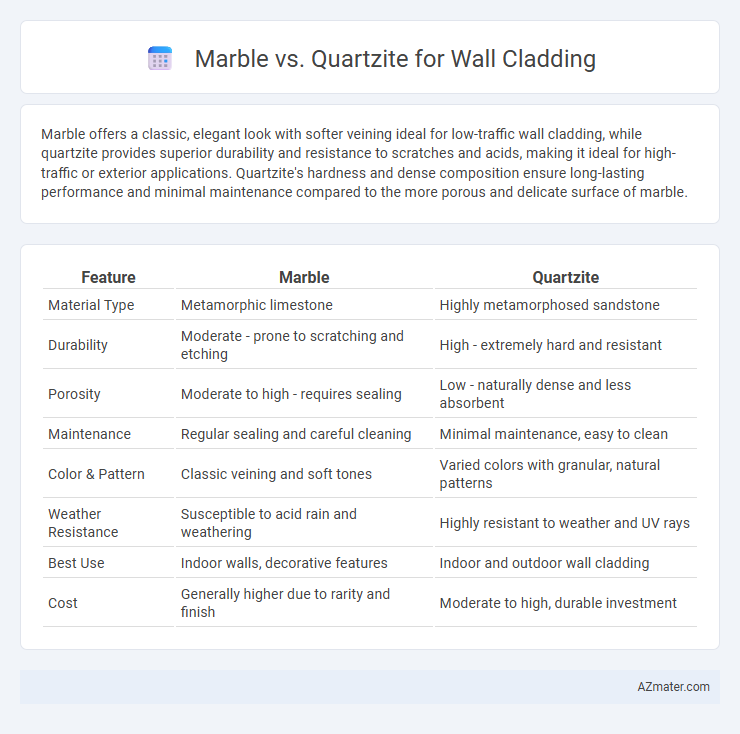Marble offers a classic, elegant look with softer veining ideal for low-traffic wall cladding, while quartzite provides superior durability and resistance to scratches and acids, making it ideal for high-traffic or exterior applications. Quartzite's hardness and dense composition ensure long-lasting performance and minimal maintenance compared to the more porous and delicate surface of marble.
Table of Comparison
| Feature | Marble | Quartzite |
|---|---|---|
| Material Type | Metamorphic limestone | Highly metamorphosed sandstone |
| Durability | Moderate - prone to scratching and etching | High - extremely hard and resistant |
| Porosity | Moderate to high - requires sealing | Low - naturally dense and less absorbent |
| Maintenance | Regular sealing and careful cleaning | Minimal maintenance, easy to clean |
| Color & Pattern | Classic veining and soft tones | Varied colors with granular, natural patterns |
| Weather Resistance | Susceptible to acid rain and weathering | Highly resistant to weather and UV rays |
| Best Use | Indoor walls, decorative features | Indoor and outdoor wall cladding |
| Cost | Generally higher due to rarity and finish | Moderate to high, durable investment |
Introduction: Marble vs Quartzite for Wall Cladding
Marble and quartzite are two popular natural stones used for wall cladding, each offering unique aesthetic and durability features. Marble features elegant veining and a softer surface ideal for interior walls, while quartzite provides superior hardness and resistance to scratches, making it suitable for both indoor and outdoor cladding applications. Choosing between marble and quartzite depends on factors like desired appearance, maintenance requirements, and exposure conditions.
What is Marble? Key Characteristics
Marble is a metamorphic rock composed primarily of recrystallized carbonate minerals, most commonly calcite or dolomite, known for its classic veining and color variations. Key characteristics include its softness compared to quartzite, susceptibility to acid etching and scratching, and its high polishability, offering a luxurious and elegant appearance. Marble's porosity requires sealing for durability in wall cladding applications, ensuring longevity and resistance to staining.
Understanding Quartzite: Features and Formation
Quartzite is a natural metamorphic rock formed from sandstone under intense heat and pressure, resulting in an extremely hard and durable surface ideal for wall cladding. Its high quartz content gives it superior resistance to scratches and weathering compared to marble, making it suitable for both interior and exterior applications. The natural crystalline structure of quartzite provides unique, shimmering patterns that enhance aesthetic appeal while maintaining structural integrity.
Aesthetics: Visual Appeal and Design Variety
Marble offers a classic, luxurious aesthetic with its smooth texture and distinctive veining patterns, making it ideal for elegant wall cladding designs. Quartzite provides a more natural, rugged appearance with subtle color variations and greater durability, appealing to modern and rustic interior styles. Both materials offer a wide range of colors and finishes, allowing for diverse design options tailored to specific aesthetic preferences.
Durability and Strength Comparison
Marble offers elegant aesthetics but is softer and more prone to scratches and etching compared to quartzite, which is a natural metamorphic rock renowned for its exceptional hardness and resistance to impact. Quartzite's superior durability makes it ideal for heavy-traffic wall cladding and areas exposed to harsh environmental conditions, retaining its structural integrity over time. While marble requires careful maintenance to prevent damages, quartzite ensures long-lasting strength and minimal wear, making it a preferred choice for robust, high-performance wall applications.
Maintenance Requirements for Each Material
Marble wall cladding requires regular sealing and gentle cleaning to prevent stains and etching due to its porous nature and sensitivity to acidic substances. Quartzite offers higher durability and resistance to scratching and heat, demanding less frequent sealing and easier maintenance with neutral pH cleaners. Choosing quartzite for wall cladding results in lower long-term upkeep and enhanced longevity in high-traffic or moisture-prone areas.
Cost Analysis: Marble vs Quartzite
Marble generally incurs higher upfront costs for wall cladding due to its premium extraction and processing methods, while quartzite offers a more budget-friendly alternative with comparable durability. Quartzite's resistance to scratching and staining reduces long-term maintenance expenses, making it cost-effective over time despite its initial price. Evaluating factors like installation complexity and lifespan, quartzite frequently delivers greater value without compromising aesthetic appeal.
Environmental Impact and Sustainability
Quartzite offers greater environmental benefits for wall cladding due to its natural durability and minimal processing requirements, reducing overall energy consumption and waste generation. Marble extraction and finishing typically involve higher carbon footprints because of intensive quarrying and chemical treatments used for polishing and sealing. Choosing quartzite supports sustainability by providing a long-lasting, low-maintenance material that minimizes resource depletion and environmental degradation.
Best Applications: Where to Use Each Stone
Marble is ideal for interior wall cladding in bathrooms, living rooms, and feature walls due to its elegant appearance and softer composition, which suits low-traffic areas. Quartzite excels in high-traffic or exterior wall cladding applications because of its superior hardness, weather resistance, and durability. For commercial spaces and outdoor facades, quartzite provides long-lasting performance, while marble enhances aesthetic appeal in more controlled indoor environments.
Conclusion: Choosing the Right Stone for Your Wall Cladding
Marble offers a classic, elegant appearance with unique veining patterns ideal for sophisticated interior wall cladding, but it is softer and more prone to scratching compared to quartzite. Quartzite provides superior durability and resistance to heat, scratches, and stains, making it a practical choice for high-traffic areas and exterior wall cladding. Selecting the right stone depends on balancing aesthetic preferences with durability requirements, where marble suits decorative, low-maintenance spaces and quartzite excels in robust, long-lasting installations.

Infographic: Marble vs Quartzite for Wall Cladding
 azmater.com
azmater.com